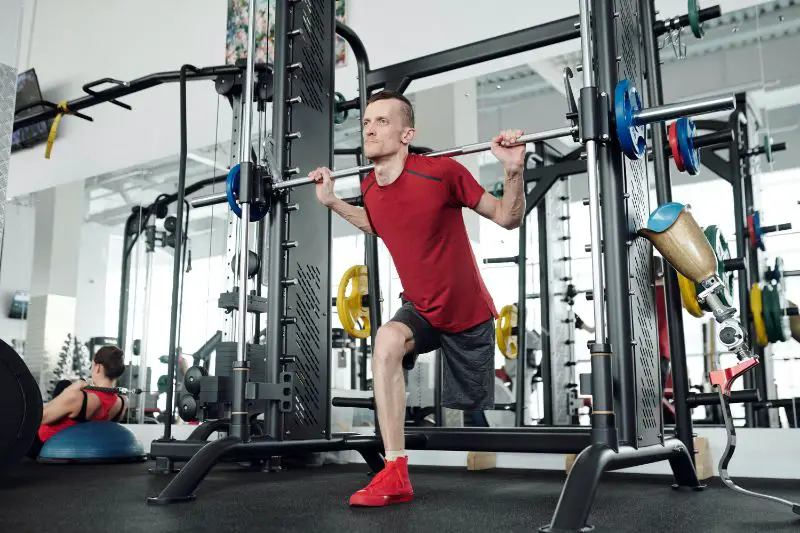
Table of Contents (click to expand)
The Importance of Weight Training in Physical Development
Weight training, often equated with strength training, is a critical component of a comprehensive exercise routine for individuals of nearly all ages. This form of physical activity focuses on resistance to induce muscular contraction, which builds the strength, anaerobic endurance, and size of skeletal muscles. It serves numerous benefits, including but not limited to healthy weight maintenance, muscle mass development, healthy blood pressure control, and body awareness and confidence enhancement.
Myths Surrounding Weight Lifting at a Young Age
Numerous myths circulate about the potential dangers of lifting weights at a young age. Despite the persistence of these misconceptions, the benefits of strength training for young athletes are supported by scientific evidence. The key lies in implementing a scaled-down version of adult workouts, focusing on proper form and technique rather than heavy lifting. This article aims to dispel such myths and clarify the age of lifting weights.
What are Strength Training and Weight Training?
Strength training and weight training are often used interchangeably. They both refer to exercises that use resistance, whether body weight, free weights, or machines, to build strength, endurance, and muscle mass. Resistance training is an umbrella term that includes both of these. A strength training program can consist of lifting free weights only but also bodyweight exercises like push-ups, pull-ups, and sit-ups.
Different Forms of Weight Training: Not Just Barbells and Dumbbells
Weight training extends beyond the typical image of barbells and dumbbells. This weight room category includes body weight exercises, kettlebell workouts, resistance band exercises, and medicine ball workouts. This vast array of exercise options allows a program to be tailored to the capabilities and goals of almost any sport or individual, regardless of age.
What Age Should You Start Lifting Weights?
The question of “What age should you start your child lifting weights?” has been a contention among parents, coaches, and healthcare professionals. The National Strength and Conditioning Association (NSCA) states that strength training can start as early as 7 or 8 years old, provided it’s supervised, focused on proper technique, and considers a child’s emotional and physical maturity.
Why is Age a Critical Factor in Starting Weight Lifting?
Age is a vital consideration in weight lifting due to physiological aspects related to the growth and development of a child’s muscles. Growth plates, areas of developing tissue, are more susceptible to injury in children and adolescents. However, a properly designed and supervised strength training program emphasizing form and technique can minimize the risk of the growth plate and other injuries. It’s always recommended to consult with a child’s doctor before they start lifting weights.
Strength Training for Children: Building Foundations
Strength training for children focuses primarily on developing essential coordination and muscle strength using body weight and light weights. Research published in the British Journal of Sports Medicine supports that resistance training for children contributes to improved body composition, better body awareness and control, stronger bones, and enhanced sports performance.
Benefits of Lifting Weights for Teenagers
As children mature into teenagers, the benefits of strength training become more pronounced. A carefully supervised program can make kids boost their self-esteem, improve physical performance, and reduce sports-related injuries. By the time they are in their late teens, young athletes can start lifting heavier weights, gradually and safely increasing their muscle mass.
Adult and Elderly Weight Training: Preserving Muscle and Bone Health
For adults and older people, weight training is crucial for preserving muscle mass and maintaining strong bones. It can also play a significant role in losing weight and maintaining a healthy weight.
Safe Weight Lifting Techniques for Children
When a child starts to lift weights, the focus should be on mastering the proper techniques of body control and learning the basic principles of strength training. Light weights and bodyweight exercises, under the supervision of a certified strength and conditioning specialist or a knowledgeable coach, should form the crux of a youth strength training program.
Strength Training for Teenagers: Balancing Growth and Exercise
Teenagers can start lifting heavier weights, but the focus should remain on proper form rather than the amount of weight lifted. The major muscle groups should be worked out, and care should be taken to avoid over-training any single muscle group.
Adult Weight Training: Maximizing Gains Safely
Adults should aim to work all the major muscle groups, gradually increasing the weight and exercise done over time. Emphasis should remain on good form to avoid injury.
Weight Training for Seniors: Strength at Any Age
Seniors can also benefit significantly from lifting weights. Resistance training can help slow the loss of muscle mass that comes with age and keep muscles that help maintain balance, thus reducing the risk of falls.
Debunking Myths: Does Lifting Weights Stunt Growth?
The myth that lifting weights stunts growth in children and adolescents has been debunked by numerous scientific studies. A study published in the British Journal of Sports Medicine concluded that when done properly, weightlifting does not negatively impact growth plates in children.
Understanding the Risks of Incorrect Weight Training
Despite the many benefits of weight training, risks exist, especially when lifting weights is not done correctly. Proper form and technique are essential to lifting and injury prevention, especially in young athletes who are still growing.
First Steps to Start Lifting Weights
For beginners of any age, it’s recommended to start lifting weights under the guidance of a professional, such as a personal trainer or organized sports someone. Starting with bodyweight exercises and gradually introducing light weights allows for the focus to be on form and technique.
Importance of Professional Guidance When Starting Weight Training
Professional guidance is invaluable when starting a strength training program. A certified trainer can ensure the weightlifting program is appropriate for the individual’s age, physical condition, and goals and can closely monitor for proper form and technique.
Designing a Safe and Effective Strength Training Routine
A well-rounded strength training routine includes exercises for all major muscle groups. The way should be varied to avoid overworking any muscle group and keep the workouts interesting.
The Role of Rest, Nutrition, and Hydration in Weight Training Success
Proper rest between workouts, a balanced diet, and adequate hydration are critical to a successful strength training program. These factors not only help to optimize performance muscle strength but also to prevent injuries.
Emphasizing the Role of Age in Starting to Lift Weights
While there’s no definitive “best age” to start lifting weights, a well-supervised strength training program can be beneficial at nearly any age. It’s essential to focus on proper form, safety, and a balanced workout routine rather than the weight being lifted.
Final Thoughts on Strength Training at Any Age
Strength training, including lifting weights, is integral to maintaining overall health and physical fitness. With proper guidance, proper technique, and a focus on safety, individuals of all ages can reap the benefits of a well-structured weight training regimen.





































